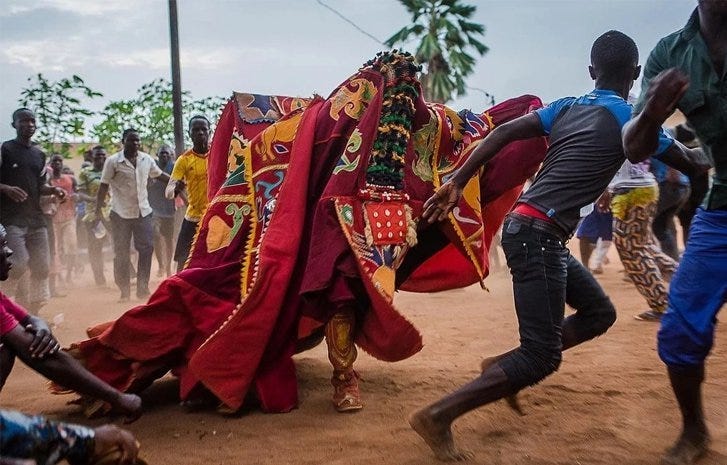At the outset of World War II, the U.S. Office of War Information commissioned a study of Japanese culture. The result, The Chrysanthemum and the Sword, introduced an enduring meme dichotomy: shame cultures (Asian) revolve around social reputation, while guilt cultures (European) emphasize internal moral judgment. Yet there is a third, often overlooked framework—one governed not by guilt or shame, but by fear.
Eugene Nida introduced this idea in 1954 to help Christian missionaries understand tribal and animistic societies, where he observed social rules based on fear of punishment—often from supernatural forces like witches. While very few societies today explicitly identify with tribes or nature-based belief systems, fear culture endures across continents and generations, and is a goldmine for fresh policy ideas.
Fear-based solutions aren’t just theoretical—they reemerge naturally in societies where colonial-era, guilt-based court systems fail to command respect. In sub-Saharan Africa and Afro-diasporic nations like Jamaica, this practice is known as “jungle justice.” For crimes like theft or moral transgressions, offenders are stoned, beaten, or burned alive while local police look on. Do they know something we don’t?
In The Culture Transplant, Garrett Jones shows how cultural traits—trust, savings habits, and attitudes toward government—persist for generations among migrants. His work challenges the assumption that assimilation erases cultural influences on economic outcomes. The same “stickiness” in attitudes toward hierarchy and coercion helps explain persistent differences in law and order outcomes in multiracial societies.
The Mouth Digs the Grave of the Body
Many scholars of pre-colonial African cosmologies have noted that fear was the ultimate sanction of social control. Spirit mediums attributed bad dreams, illness, and difficult births to punishments from ancestors, witchcraft, or magic.1 Traditional healers reinforced this fear to ensure communities upheld rituals and moral behavior. This stands in stark contrast to the Christian God, who offers forgiveness for sins.
A 1999 study found higher levels of fear in Nigerian and Kenyan children compared to children from the United States, Australia, and China. The most common type of fear reported was fear of supernatural beings such as ghosts. Although the African ethnic groups mostly nominally adhered to Christianity or Islam, animistic religious beliefs were still common, as well as beliefs in the continued spiritual presence of ancestors.2
A 2009 Pew report found African Americans more likely than Americans overall to believe in angels and demons (83% vs 68%) and interpret Scripture literally (55% vs 33%).3 This isn’t a church issue,4 as unaffiliated blacks (33%) held literal biblical views at higher rates than Protestants (22%), Catholics (23%), and the overall unaffiliated population (11%). Similar patterns emerge for belief in miracles and life after death.
A focus on supernatural fear makes sense given racial differences in cortisol levels and startle reflex responses. In a controlled experiment, African Americans showed lower reactivity to loud noises and filtered out distractions more effectively than European Americans—suggesting a naturally desensitized baseline. The Sensitive Young Man recoils at a slap on the wrist; a tougher man may need a bigger rod.
Deaf to Mama, Blind to Danger
Cold men in lab coats don’t need to tell communities what black mothers already know. Pew data from 2015 shows that black parents are twice as likely as White parents to use spanking (32% vs. 14%) and far less likely to rule it out completely (31% vs. 55%). White parents worry more about their kids developing anxiety (58% vs. 35%), while black parents worry more about their kids getting shot (39% vs. 22%).5
All parents want what’s best for their children, but they teach through different tools. For black parents, fear is a lesson: wrongdoing—like joining a gang and risking a bullet—must bring painful consequences.6 White parents, following a different cultural logic, prefer time-outs to induce guilt, or logical explanations, to appeal to conscience. If the discipline must fit the child, then why not the citizen?

So far, I’ve focused on guilt vs. fear, but City Journal has mused on shame-based crime prevention. A common example is Asian-run shops posting photos of shoplifters to embarrass them. But ghetto criminals with no shame already post their own crimes on social media—and anyway, the more prestigious “criminal justice reforms,” pushed by international aid groups, lean on restorative justice, which assumes empathy and guilt.
Collapsing guilt-Americans, shame-Americans, and fear-Americans into a single generic “American” has produced as much confusion as the Effective Altruist attempt to equate human suffering with shrimp suffering. As Lyman Stone wrote, shrimp forget pain after just 3% of their lifespan. Do you? Pain isn’t the same for all sentient beings. “There but for the grace of God go I” is a beautiful idea—but it isn’t true.
Different Clocks: How Criminals Think
As a guilt-American, Stone measures pain by its lasting impact—but criminals think in the moment. A longitudinal study from 1966 to 1984 found that a Swede’s preference for immediate rewards at 13 makes him 32% more likely to be convicted of a crime by 31. The link is stronger among males with below-average intelligence.7 What happens to the stupid, impulsive male in Western courts is immeasurably cruel.
In the name of abolishing “barbarism,” reformers have replaced swift, effective punishments—like flogging, which cemented the link between wrongdoing and pain—with a byzantine maze of “due process.” Murderers and rapists, many unable to recognize their crimes as wrong, are asked to confess and repent. Confused by guilt-based rituals, fear-Americans see the prison system as a “new Jim Crow” or slavery.
This isn’t a call for radical reform but for respecting natural postcolonial reversions to “jungle justice”. USAID-backed groups like Afrobarometer fund surveys then lament the results: in 2023, 71% of respondents feared retaliation for reporting corruption.8 But what if corruption isn’t bad, and fear works? Instead of stamping out “barbarism,” why not embrace some Chinese wisdom—“let barbarians govern barbarians.”9
Moral realists have terrorized and confused our pluralist society for too long. They impose guilt-based rituals on those who feel no guilt, expecting moral introspection from those who only understand force. Let guilt-Americans have their “due process,” shame-Americans their public humiliation, and fear-Americans their swift retribution. At least then, everyone would be playing by rules they understand.
Another review explains: “In Africa, generally, misfortune is not regarded as a natural occurrence or merely bad luck. Instead, every significant misfortune is believed to be caused by a spiritual force strongly motivated in a morally understandable way.”
Conversions to Axial Age religions in places such as Melanesia often remain shallow and relationship-based. Missiologists call this 'secondary conversion'—which concerns genuine Christians because these converts frequently switch faiths when new social ties form.
Pew has continued its Religious Landscape Study into 2025, and I recommend reading it, but discontinued questions about angels and demons, for reasons I am sure you can guess.
But black churches often emphasize a “fire and brimstone” style of preaching, emphasizing the fear of God and divine punishment for sin, more so than many white churches.
As with the religion study, the 2023 update to this parenting study skips the more colorful questions about spanking and gun violence that made the 2015 report so interesting.
Caring schoolteachers acting in loco parentis also use corporal punishment more frequently in schools with higher black student populations, and especially on black students.
I don’t mean to pick on Sweden. They just provide a lot of high-quality data for such studies.
Mauritania is the only country where a majority of citizens (61%) feel safe reporting corruption, despite its bad reputation for maintaining a Arab vs Sub-Saharan caste system.
The chengyu is yǐ yí zhì yí (以夷制夷). You may disagree with my translation.





Why not do all three? Why not have guilt, shame, and fear built into the system simultaneously?
I remember reading various laws saying the punishment is either "5 years in prison or a $5,000 fine", and I am like 'why not both'? Screw over the rich criminal who doesn't want his body inconvenienced by prison and screw over the poor criminal who doesn't want his wallet inconvenienced by a fine. Do all of the above, everything and the kitchen sink.
Eric Posner talks about the shortcomings of shame-based punishments in Law and Social Norms (2000), at p. 92. He also points out that shame can be excessive when everyone else trys to signal they're a "good cooperator" by ostracizing the offender, even is his crime was not that serious.